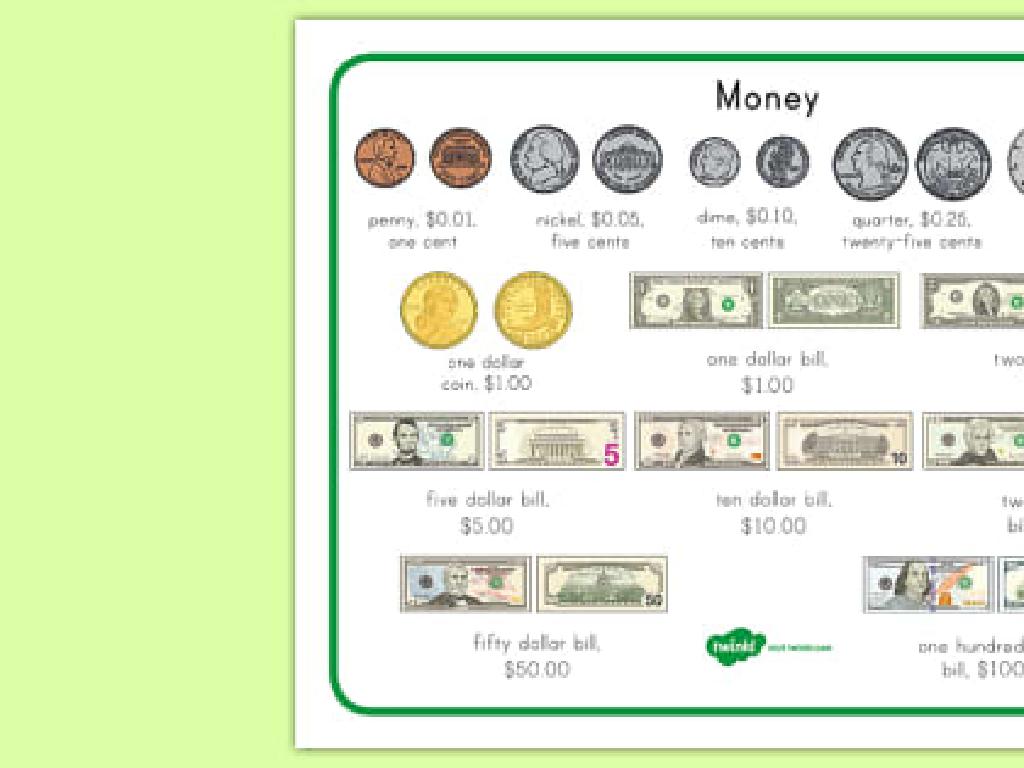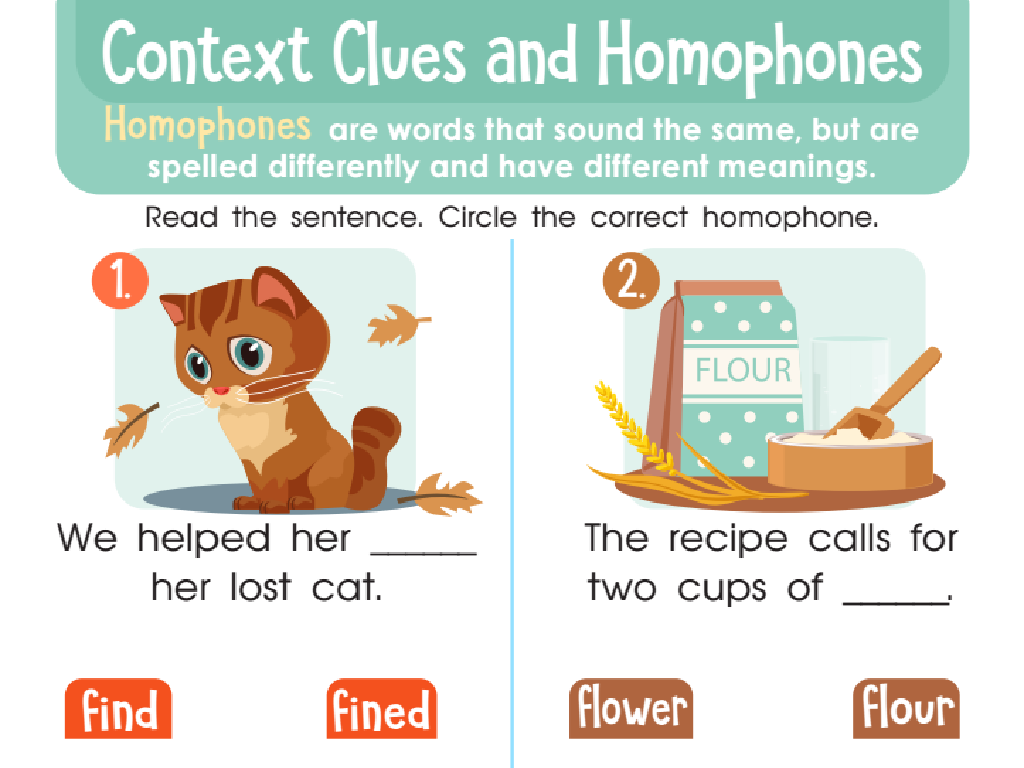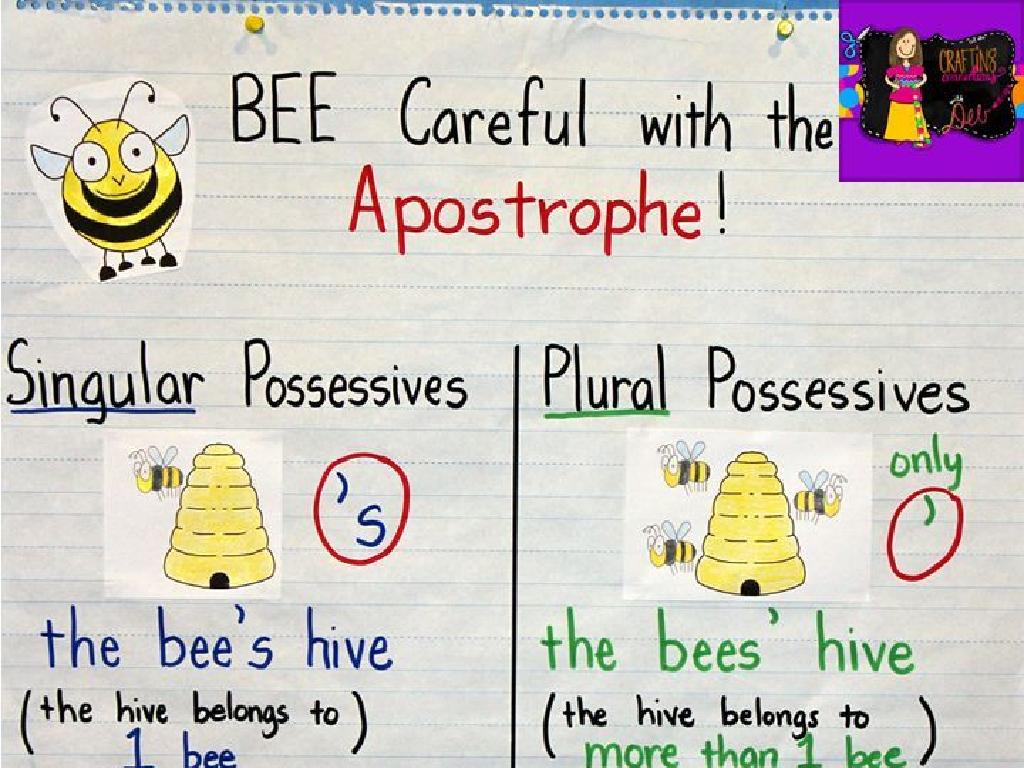Particle Motion And Changes Of State
Subject: Science
Grade: Eighth grade
Topic: Particle Motion And Energy
Please LOG IN to download the presentation. Access is available to registered users only.
View More Content
Particle Motion and Changes of State
– Matter’s tiny building blocks
– Matter is made of atoms and molecules, the smallest units of chemical elements.
– Particle movement in states of matter
– In solids, particles vibrate in place; liquids have particles that slide past each other; gases have free-moving particles.
– State changes and particle motion
– When matter changes state, like ice melting, particles move from a structured solid to a more fluid liquid.
– Exploring real-world examples
– Consider water: solid ice, liquid water, and water vapor demonstrate changes in particle motion with state.
|
This slide introduces the concept of particle motion and how it relates to the states of matter and changes of state. Begin by explaining that all matter is composed of tiny particles too small to see. These particles behave differently depending on whether the matter is a solid, liquid, or gas. Emphasize the energy changes involved in transitions between states, such as when heat causes ice (solid) to melt into water (liquid). Use water as a relatable example to show these concepts in action. Encourage students to think of other examples and how temperature affects the state of matter. This will set the foundation for understanding the relationship between particle motion and energy.
Exploring Matter and Its States
– Matter: Everything is made of it
– States of matter: solid, liquid, gas
– Solids have fixed shape, liquids flow, gases expand to fill containers
– Particle motion defines state
– Particles move slower in solids, faster in liquids, and fastest in gases
– Energy’s role in state changes
– Adding or removing energy can change matter’s state, like melting ice
|
This slide introduces the concept of matter and its different states as part of the broader topic of particle motion and energy. Matter is the substance that makes up all physical objects in the universe, and it can exist in three primary states: solid, liquid, and gas. The state of matter is determined by the motion of its particles and the energy they possess. In solids, particles vibrate in place, while in liquids, they move more freely, and in gases, they move rapidly and are far apart. Changes in energy, such as heating or cooling, can cause matter to change from one state to another. This is a fundamental concept in understanding the physical world and will be the basis for exploring how particle motion relates to energy and changes of state.
Particle Motion in Solids
– Particles are tightly packed
– Particles are so close they’re almost touching.
– Vibrations in fixed positions
– Particles wiggle in place but don’t change location.
– Solids have a fixed shape
– The rigid structure of particles gives solids a definite shape.
– Solids have a fixed volume
– Because particles don’t move apart, solids maintain their volume.
|
This slide introduces the concept of particle motion within solids. Emphasize that in solids, particles are packed closely together, which restricts their movement to only vibrations in their fixed positions. This lack of free movement is what gives solids their fixed shape and volume, unlike liquids or gases where particles move more freely. Use examples like ice or a rock to illustrate how the structure of solids is maintained. Encourage students to think about how heating a solid might affect particle motion, leading to a change of state, as a segue into the next topic of discussion.
Particle Motion in Liquids
– Particles are close but mobile
– Particles can slide past one another, giving liquids a fluid nature.
– Liquids flow and fit containers
– They adapt to the shape of any container they’re placed in.
– Fixed volume, variable shape
– Unlike gases, liquids don’t expand to fill the space; they keep a consistent volume.
– Movement allows mixing
– This mobility allows substances to mix or dissolve in liquids.
|
This slide introduces the concept of particle motion in liquids, which is a key aspect of understanding states of matter. Emphasize that while particles in liquids are close together, they are not locked in place and can move past each other, which allows liquids to flow. This is why liquids take the shape of their container but maintain a fixed volume. The ability of particles to move past each other also explains why substances can mix or dissolve in liquids. Use examples like pouring water into different shaped containers or sugar dissolving in tea to illustrate these points. Encourage students to think about how the movement of particles differs in solids, liquids, and gases.
Particle Motion in Gases
– Gas particles move freely
– Particles have large spaces between them, allowing for free movement
– Gases expand to fill containers
– When placed in a new container, gases spread out evenly
– No fixed shape or volume
– Unlike solids and liquids, gases adapt to the shape and volume of their surroundings
– Particles are far apart
|
This slide introduces the basic properties of gases as they relate to particle motion. Emphasize that gas particles are in constant, random motion and are much farther apart than in solids or liquids, which allows them to move freely. Highlight that because of this free movement, gases do not have a fixed shape or volume and will always expand to fill the available space in their container. This is a fundamental concept in understanding the behavior of gases and sets the stage for discussing how temperature and pressure affect gas particles.
Particle Motion: Changes of State
– Matter transitions between states
– Types of state changes
– Melting, freezing, vaporization, condensation, sublimation, deposition
– Energy’s role in state changes
– Energy is either absorbed or released during state transitions
– Observing energy exchange
– Heat absorption melts ice; heat release freezes water
|
This slide introduces the concept of changes of state as a part of particle motion and energy. Students should understand that matter can transition between solid, liquid, and gas states. Key changes of state include melting (solid to liquid), freezing (liquid to solid), vaporization (liquid to gas), condensation (gas to liquid), sublimation (solid to gas), and deposition (gas to solid). During these changes, energy is either absorbed from the environment (endothermic) or released into the environment (exothermic). For example, ice absorbs heat to melt, while water releases heat to freeze. Encourage students to think of everyday examples of these processes and discuss why energy must be absorbed or released during the change of state.
Energy and Particle Motion
– Adding heat increases motion
– Particles move faster when heated
– Cooling decreases particle motion
– Particles slow down when cooled
– Energy changes affect state
– Solid to liquid to gas with heat
– Examples of state changes
– Ice melting, water boiling
|
This slide introduces the concept of how energy affects particle motion and the resulting changes of state. When energy in the form of heat is added to a substance, its particles move faster, which can cause the substance to change from solid to liquid (melting) or from liquid to gas (evaporation). Conversely, removing energy by cooling can slow down the particles, leading to a change from gas to liquid (condensation) or from liquid to solid (freezing). Use everyday examples like ice melting or water boiling to illustrate these points. Encourage students to think of other examples where adding or removing heat changes the state of a substance.
Particle Motion: Changes of State
– Ice melting into water
– Solid to liquid: particles gain energy and move apart
– Water boiling into steam
– Liquid to gas: particles gain more energy and spread out
– Dew forming on grass
– Gas to liquid: particles lose energy and come closer
|
This slide presents real-life examples of changes of state to help students visualize particle motion and energy changes. When ice melts into water, it’s a transition from solid to liquid where particles gain energy and move from a fixed position to sliding over each other. Boiling water into steam represents a liquid to gas change, where particles gain even more energy and spread out to move freely. Conversely, dew forming on grass shows gas to liquid transition, where water vapor particles lose energy and come closer together to form liquid. Encourage students to think of other examples they encounter daily and discuss how temperature changes affect particle motion in these states.
Class Activity: Observing Particle Motion
– Observe state changes in an ice cube
– Predict effects of adding heat
– What do you think will happen to the ice cube?
– Discuss particle motion during melting
– How do particles move in solid, liquid, and gas states?
– Record observations and conclusions
|
This class activity is designed to help students understand the concept of particle motion and changes of state through direct observation. Provide each student or group with an ice cube and a source of heat. Ask them to predict what will happen when the ice cube is heated and to pay close attention to the changes as the ice melts. Guide the discussion towards understanding that particles move from being tightly packed in a solid state to moving more freely in a liquid state, and eventually spreading far apart in a gas state. Encourage students to take notes on their observations and to draw conclusions about the relationship between heat and particle motion. Possible activities include measuring the time it takes for the ice to melt at different temperatures, or comparing the melting of pure ice to ice with salt sprinkled on it.
Particle Motion: Conclusion and Recap
– Review particle motion states
– Solids have particles vibrating in place, liquids flow, gases move freely.
– Energy’s role in state changes
– Adding or removing energy can change a substance’s state, e.g., melting ice.
– Matter’s relevance in science
– Understanding matter is fundamental to scientific principles and phenomena.
– Daily life applications
– From cooking to weather, changes in matter’s state affect our everyday experiences.
|
This slide aims to summarize the key concepts of particle motion and changes of state. It’s crucial to reinforce the idea that particles behave differently in solid, liquid, and gas states, and that these behaviors are influenced by energy. Emphasize the practicality of this knowledge by discussing how heating or cooling affects matter around us, such as water turning to ice or steam. Highlight the importance of understanding these concepts for future scientific studies and their omnipresence in students’ daily lives, from the water cycle to the functioning of household appliances.
Interactive Quiz: Particle Motion and Changes of State
– Engage in a fun knowledge quiz
– Answer questions on particle motion
– How do particles move in solids, liquids, gases?
– Explore changes of state through quiz
– What happens to particles during melting, freezing?
– Reflect on today’s learning
|
This interactive quiz is designed to consolidate the students’ understanding of particle motion and changes of state. Prepare a series of multiple-choice and true/false questions that cover the key concepts discussed in today’s lesson. Questions should probe students’ grasp of how particles behave differently in various states of matter and the processes involved in transitions between these states. Use this activity to gauge the class’s comprehension and to reinforce learning through immediate feedback. Possible activities include a Kahoot quiz, a hands-on demonstration with student volunteers, or a worksheet that they can fill out in real-time. Ensure that the quiz is engaging and accessible to all students, providing a fun way to review the material.
Homework: States of Matter and Energy
– Diagram particle motion in solids, liquids, gases
– Explain energy’s effect on particles
Particles move faster with more energy, slower with less.
– Describe a real-life state change
Example: Water boiling into steam requires heat energy.
– Discuss the energy in state changes
Consider melting ice or evaporating water and the energy input.
|
This homework assignment is designed to help students visualize and understand the concept of particle motion in different states of matter and the role of energy in these processes. Students should draw clear diagrams showing the arrangement and motion of particles in solids, liquids, and gases. They must write a paragraph explaining how adding or removing energy can affect particle motion, leading to changes in state. Encourage them to think of everyday examples, such as water boiling or ice melting, to describe how energy is involved in changing states. This will reinforce their understanding of the relationship between particle motion and energy.






